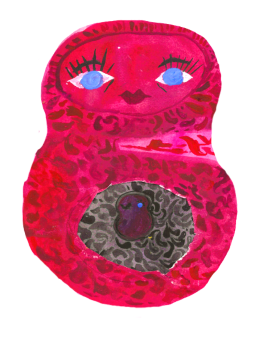For this task we had to pick our favourite image and give it to someone to draw over, while simultaneously drawing over someone else's image
before
after
Respecting someone by engaging and respecting someone by diminishing yourself
At the beginning of this task I was feeling quite confident in giving away this image but my opinion changed when I got it back.
The blue portrait stands out a more but it looks much less deliberately placed than the orange one. It feels as if it's not from the same universe as the original image, almost inviting me to peel it of. It's looking straight at me trough the page, taunting me. While it does change the original image, I don't feel like it necessarily adds to it in any way, as it's too far removed from the context of the page.
In contrast, I quite like the orange portrait. The fact that it's softer makes it feel like it could be part of the page, while the angle (profile, looking down) makes it feel like it's looking at the images below, lost in thought. It almost feels nostalgic, similar to how I feel looking back at old drawings.
Overall, I think with both images overlayed it ends up looking quite messy. In the beginning I was a bit upset about it, but after I thought more about it I realised that it's not about my drawing (which I could also just print out), but about the act itself. After that I started thinking about the act of boldly going over my drawing as an act of respect by fully engaging in the task as a whole, which is a good thing regardless if I like the drawing or not.
I think this task was a great way to work collaboratively, as usually with group projects, when they aren't anonymous like this one, people tend to not insert themselves into someone else's idea as much, making this really good practice for future professional projects, when people tend to overlap ideas more.


In the drawing that I made over people's work I didn't want to do something too bold, especially in the first one where I drew on another layer to avoid upsetting the person.
If I were to do this again I would probably try to come up with a better way of changing the image in a significant way instead of just drawing over it thoughtlessly.


I made the first collage before the reveal.
I tried to incorporate general elements that can depict a journey, as well as Emily-specific elements, mainly the fact that she was left to become a seamstress, so I used a piece of thread attached to a needle to guide the viewer through her journey, as her life journey was also dictated by the fact that she was a seamstress. The needle is circling a person on the boat that is supposed to be her.
Working on this collage made me feel quite guilty as I thought that this was a real person and I was using images not related to her to essentially fabricate her story.
I finished the second collage after we found out that we were lied to.
The knowledge that she isn't real and that neither are the photos made me feel more comfortable lying about her life story.
Here I added a fake letter to her parents as well as clothing patterns that she could've made. Before I knew she didn't exist I hesitated to do this as I couldn't find any info about her or her work and I didn't want to lie about it.
After the reveal, I can see that making this image was very similar to creating a movie about a true story. Lying to create a narrative can be a great way to bring awareness to real events, in some cases being more efficient than news or other, more factual, information-sharing methods. It can make the public more engaged and more empathetic towards the people taking part in said event as they can also partake through the eyes of a character, offering a subjective view as opposed to the objective view we are used to when we observe events far from us or from a different time period. Creating a narrative about a true story, that is made up but still sensible and factual enough can also reach a wider public by being more palatable that simply listing information.
